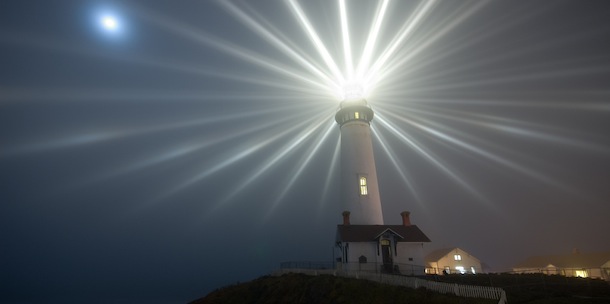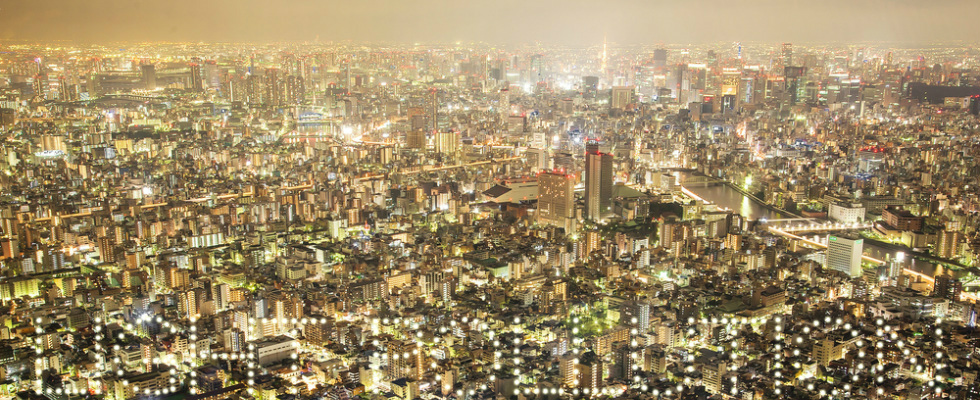
Light Pollution
Light pollution is excessive, misdirected or misused light that can harm human health, wildlife, ecosystems and astronomy. Although light pollution is one of the least known types of pollution, its effects on human health and ecosystems can be just as serious as some of the better-known forms of pollution. Light pollution is most severe in large cities, especially in North America and Europe, and in other built-up areas such as Japan and in major cities in the Middle East and North Africa like Tehran and Cairo, but even relatively small amounts of light can be noticed and create problems in rural areas as well. Light pollution is a
side effect of industrial civilization. Its sources include building exterior and interior lighting, advertising, commercial properties, offices, factories, streetlights, and illuminated sporting venues.
Learn more.
The American Medical Association has issued an official statement warning against the health hazards posed by exposure to artificial, excessive light at night and for hours at work or during sleep, including disrupting sleep, exacerbating sleep disorders, causing unsafe driving conditions and a higher risk of developing prostate cancer. Learn more.
Forms of Light Pollution
Light Trespass
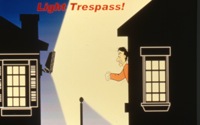
Courtesy: RAB Lighting
Light trespass occurs when
spill light, which is light that falls outside the area intended to be lit, is cast where it is not wanted. A typical light trespass problem occurs when a
strong light enters the window of one's home from the outside, into a neighbor's property from streetlights or floodlights or as a distraction to drivers, causing problems such as sleep deprivation, visual confusion or the blocking of an evening view. Light trespass, which
causes annoyance, discomfort, distraction, or a reduction in visibility
is an all-too- common by-product of poor lighting design or inadequate optical control in light fixtures.
Light trespass can be reduced
by selecting light fixtures which limit the amount of light emitted more than 80° above the nadir.
Learn more.
Glare
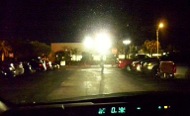
Image Credit: Chuck Bueter www.nightwise.org
Glare is when light strikes your eyes directly from the source. This visual sensation, caused by excessive and uncontrolled brightness, can be blinding, disabling, damaging to one's health or simply uncomfortable.
Glare from bad lighting is a public health hazard, especially the older you become.
Glare light scattering in the eye causes loss of contrast and leads to unsafe driving conditions, much like the glare on a dirty windshield from low-angle sunlight or the high beams from an oncoming car. These bright, usually badly shielded, lights around roads can
partially blind drivers or pedestrians and contribute to accidents. As we age, the
effects of glare
on our lives at night becomes worse.
Learn more.
Over-Illumination

Some big-box retail stores are over-illuminated at over twice the recommended levels | Wikipedia Commons
Over-illumination is the excessive or inefficient use of lighting, such as leaving lights on when they are not being used, using poorly designed lighting that illuminates areas that don't need to be illuminated or illuminates areas more brightly than necessary. This becomes expensive and energy-intensive, especially overtime. Within the United States,
over-illumination is responsible for approximately two million barrels of oil per day
in energy wasted. The
health effects of over-illumination
include increased headache incidence, worker fatigue, medically defined stress, decrease in sexual function and increase in anxiety. Consideration should be taken for both the appropriate level of illumination required when spaces are in use and when they are unoccupied.
Learn more.
Light Clutter
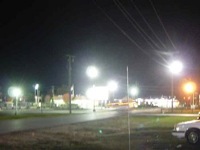
Image Credit: Chuck Bueter www.nightwise.org
Light clutter refers to excessive groupings of lights, especially bright or flashing lights, which can generate confusion, distract from obstacles and potentially cause accidents. Light clutter is a
great concern to drivers and pilots as it can cause confusion and disorientation. Clutter is particularly noticeable on roads where the street lights are badly designed or where brightly lit advertising surrounds the roadways and is also a hazard in the aviation environment if
aviation safety lighting must compete for pilot attention with non-relevant lighting.
Learn more.
Skyglow
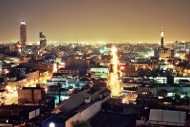
Mexico City at night, with a brightly illuminated sky | Source: Fernando Tomás, bambino, flickr
Skyglow is the illumination of the night sky, most referred to as the "glow" effect that appears over populated areas at night. Skyglow is mainly a
combination of reflected light from illuminated areas and badly directed light escaping into the sky, where it is scattered by the atmosphere and redirected back at the ground. Although
skyglow occurs naturally, the most common cause is artificial light that emits light pollution, which accumulates into a vast glow that can be seen from miles away and from high in the sky. Skyglow diminishes the beauty of the star-filled sky, which is of particular importance to astronomers, and impacts plants, crops, animals, birds, nocturnal organisms, humans and other biological systems.
Learn more.
On a clear, dark night about 2,500 stars should be visible to the naked eye. On the same night in a moderately illuminated suburban area, only 300 stars can be seen. Learn more.
Effects of Light Pollution
Human Health

According to medical research, excessive light on the human body can have a variety of
adverse health effects
may be caused by light pollution or excessive light exposure, such as increased headache incidence, worker fatigue, medically defined stress, decrease in sexual function and increase in anxiety. When humans are exposed to indoor or outdoor light at night,
studies have shown that serum levels of melatonin decrease, which leads to an increased risk of certain types of cancers and other chronic diseases. This
interference with the production of melatonin, which serves many functions in the human body, primarily regulating the daily cycles of our systematic activities and
can also lead to sleep disorders by desynchronizing our internal rhythms and clock, which impairs our ability to sleep and wake at the appropriate times and leads to a decrease in cognitive and motor skills. Furthermore, the
24-hour day/night cycle, known as the circadian clock, affects psychological processes, such as brainwave patters, hormone production, cell regulation and other biological activities, not just in humans, but in virtually all organisms. Disruption of the natural circadian rhythms can even
cause weight gain and impulsive behavior.
Night-time activity may also increase the incidence of breast cancer, since bright light at night diminishes the body's supply of melatonin, the hormone involved in the control of the body's natural rhythms, which can lead to an increase in the levels of the female sex hormone oestrogen, which has been linked to breast cancer.
Learn more.
International Dark-Sky Association: Light Pollution and Human Health
Astronomy
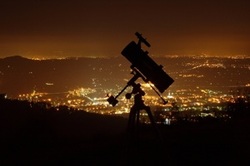
Both
amateur and professional astronomy is very sensitive to light pollution. Skyglow, which is the scattering of light in the atmosphere, reduces the contrast between stars, galaxies and the sky itself, rendering the night sky viewed from urban areas to have no resemblance to what can be seen from dark skies. A recent study revealed that about
two-thirds of the world's population can no longer look upwards at night and see the Milky Way. Light pollution is not just a problem for astronomers in or near urban areas -
due to turbulent currents in the atmosphere, light pollution can drive professional astronomical observatories to the top of the most remote mountains. A study, presented by Harald Stark from the National Oceanic and Atmospheric Administration to the American Geophysical Union, found that
light pollution destroys nitrate radicals thus preventing the normal night time reduction of atmospheric smog
produced by fumes emitted from cars and factories, which further worsens the night sky for astronomers. The problem with light pollution is that a
vast proportion of light fittings shine light above the horizontal and up into the sky. The resulting stray light bounces off particles and industrial pollutants in the atmosphere straight back down to Earth as the characteristic orange color of sky glow. The effect on the astronomer is that it lowers the contrast between it and objects in the sky, making them hard, if not impossible, to see.
Learn more.
"If we don't reverse this trend, the entire globe will soon be wrapped in a glowing envelope through which none of the magic of the Universe can be seen by the naked eye." ~
George Eslinger, former Director of the Los Angeles City Bureau of Street Lighting.
Learn more.
Wildlife and Ecosystems
All animals, including humans, depend on a regular interval of daylight and darkness for
proper functioning of behavioral, reproductive and immune systems. Many of these animals need the natural night to survive and for thousands of species, the natural dark night of the evolutionary past is an
integral component of their continued existence.
Artificial night lighting harms species directly
by triggering unnatural periods of attraction or repulsion that lead to disruptions in reproductive cycles by fixation, disorientation or by interfering with feeding and sustenance. Light pollution can cause
disorientation to wildlife or act as an unnatural stimulus. For example,
sea turtle hatchlings are disoriented by lights
along the beaches where females lay their eggs and the attraction of insects to light results in the
deaths of billions of insects each summer in Germany
alone. Even the
milk production in dairy animals can be detrimentally effected by lighting. This artificial night lighting
disrupts the natural rhythms of light and dark which govern the feeding, breeding and migration patterns of nocturnal insects, including moths, beetles, water fleas and lacewings and can have a profound effect on ecosystems. It is estimated that
a third of flying insects attracted to street lights will die as a result, either from collisions with a hot lamp or being picked off by canny predators. Estimates by the U.S. Fish and Wildlife Service on the
number of birds killed after being attracted to the lights on tall structures range from 4 to 5 million per year
with similar disorientation being noted for
bird species migrating close to offshore production and drilling facilities.
Learn more.
International Dark-Sky Association: Light Pollution and Wildlife
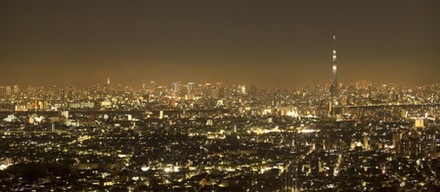
The Ecological Society of America: Ecological Light Pollution
IDA: Effects of Artificial Light at Night on Wildlife

Furthermore,
many reproductive activities are synchronized by light, or they require specific lighting conditions, such as
fireflies using lights to attract mates, a communication that artificial lights make less visible and other species, such as some insects and frogs,
only mate in the darkest part of the night, presumably to minimize the risk of predation. Lighting conditions also affect the competition and predation among species, benefiting some while harming others. Like humans, animals adjust their internal clocks based on light cues, which can interrupted and harmed by light pollution.
Alterations of the natural pattern of light disrupts the circadian cycles for wildlife
affecting the biochemical, physiological, or behavioral processes of organisms. In many species, exposure to light at night
suppresses the production of the hormone melatonin, which can have far reaching consequences.
Learn more.
Despite the positive or negative effects light at night can have for individual species, its presence invariably disturbs ecosystems. Light pollution greatly
harms trees by preventing them from adjusting to seasonal variations
and
disrupts plant photoreceptors, which are proteins that perceive information vital for plant development from the light environment.
Light pollution poses a serious threat in particular to nocturnal wildlife, having negative impacts
on plant and animal physiology, confusing animal navigation, altering competitive interactions, changing predator-prey relations, and causing physiological harm.
Light pollution around lakes prevents zooplankton from eating surface algae, which helps cause algal blooms that can kill off the lakes' plants and lower water quality.
Learn more.


